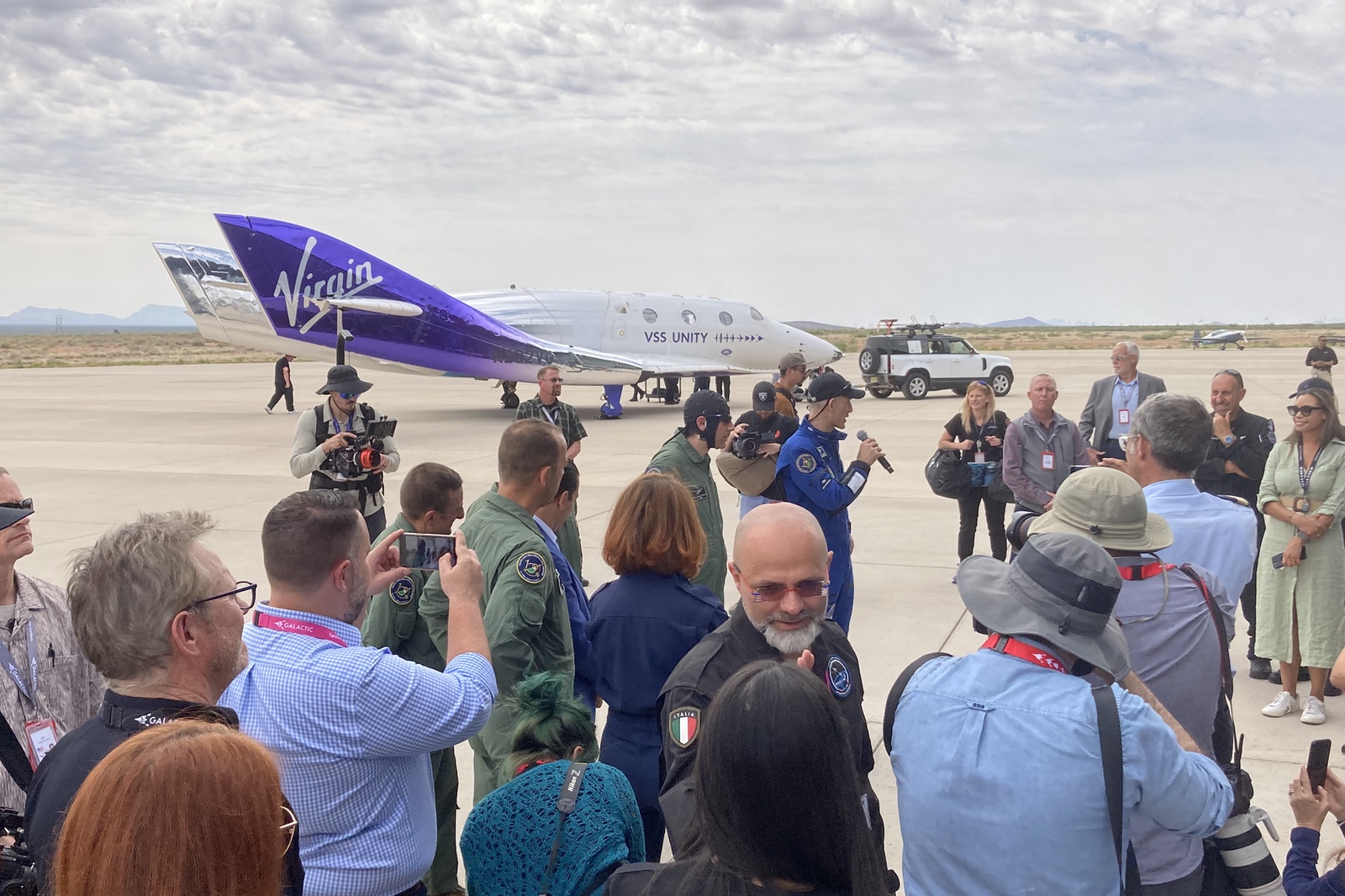Updated 4:40 p.m. Eastern with post-flight comments.
SPACEPORT AMERICA, N.M. — After nearly two decades of development, Virgin Galactic conducted its first commercial SpaceShipTwo suborbital flight June 29.
Virgin Galactic’s SpaceShipTwo vehicle VSS Unity, separated from its VMS Eve mothership aircraft at about 11:29 a.m. Eastern above cloudy skies in southern New Mexico. The vehicles took off from Spaceport America at 10:30 a.m. Eastern.
Unity, flying a mission designated Galactic 01, fired its hybrid rocket motor for approximately 60 seconds. It reached a peak altitude of 85. 1 kilometers before gliding to a runway landing at the spaceport at 11:43 a.m. Eastern.
“It was excellent,” Mike Moses, president of spaceline missions and safety at Virgin Galactic, said in an interview after the flight. “Everything was right down the middle.”
The Galactic 01 mission was a research flight for the Italian Air Force and Italy’s National Research Council. Virgin Galactic and the Italian Air Force signed the contract for the flight in October 2019, agreeing to fly three Italian payload specialists on a dedicated research flight.
The mission, called Virtute 1 by the Italian government, carried Col. Walter Villadei and Lt. Col. Angelo Landolfi of the Italian Air Force and Pantaleone Carlucci of Italy’s National Research Council. The three planned to conduct 13 experiments during the mission, ranging from biomedical data collection to microgravity studies of fluid mechanics and combustion.
In a press conference after the flight, the three Italians said they were pleased with the flight. “It was much better than expected,” Villadei, who commanded Virtute 1, said. He noted the crew was able to carry out all their planned experiments.
Villadei, who has previously trained with Axiom Space for a commercial flight to the International Space Station and was a backup for that company’s Ax-2 mission in May, said he believed suborbital flights like this were a good stepping stone to orbital missions. “It is a good environment and opportunity to really test all the things that astronauts are supposed to do once they get to the ISS.”
The research nature of the flight left them with only a little time to enjoy the flight. “The time to look outside the window was very short,” said Landolfi. “I had an opportunity to watch very quickly outside and it was beautiful.”

Also on the flight was Colin Bennett, a Virgin Galactic astronaut trainer who previously flew on VSS Unity in 2021. He flew to monitor the research environment during the flight and “do a holistic evaluation of the research mission so that we can continually improve on the experience,” said Sirisha Bandla, vice president of government affairs and research operations at Virgin Galactic, in a June 28 interview.
VSS Unity was flown by Mike Masucci, making his fourth spaceflight, along with Nicola Pecile, a former Italian Air Force pilot who now works for Virgin and was on his first spaceflight.
Company founder Richard Branson announced plans for Virgin Galactic in September 2004, just before SpaceShipOne won the $10 million Ansari X Prize with a pair of suborbital flights from the Mojave Air and Space Port. Virgin Galactic would license SpaceShipOne’s technology from vehicle developer Scaled Composites and funder Paul Allen for a larger vehicle capable of carrying up to six passengers.
At the time, Virgin Galactic contemplated beginning commercial service as soon as 2007. However, development of the WhiteKnightTwo carrier aircraft, now called VMS Eve, and SpaceShipTwo took far longer than anticipated. The company also suffered the loss of the first SpaceShipTwo vehicle, VSS Enterprise, in an October 2014 test flight accident that killed Scaled Composites pilot Mike Alsbury.
The company appeared ready to begin commercial service in 2021 with the Unity 22 flight that July that carried Branson along with several Virgin Galactic employees. The Italian Air Force flight was scheduled for that fall, followed by a maintenance period for both VMS Eve and VSS Unity. However, Virgin decided in October 2021 to begin that maintenance period early and delayed the Italian flight.
Virgin Galactic resumed test flights of VSS Unity this spring, including a May 25 flight called Unity 25 that was the vehicle’s first suborbital spaceflight since the Unity 22 mission. After Unity 25, the company said it was ready to begin commercial service with the Galactic 01 flight.
At that time the company said it would follow Galactic 01 with a series of private astronaut missions on a monthly cadence, serving a backlog of about 800 people who have signed up to date. The first of those, Galactic 02, is scheduled for August.
Moses said the company has plans laid out for monthly flights through the end of the year. That pace is driven primarily on the inspections of the vehicles between flights, a process that will be simpler and shorter for its future Delta-class spaceplanes the company is designing.
“As we do it and we don’t find anything we’ll be able to reduce that a little bit and go a little faster,” he said. “But the reality is while we just have this one spaceship, flying once a month is a good cadence for us.”
“This historic flight was our first commercial flight and our first dedicated commercial research mission, ushering in a new era of repeatable and reliable access to space for private passengers and researchers,” Michael Colglazier, chief executive of Virgin Galactic, said in a post-flight statement. He confirmed plans to begin private astronaut flights in August.
The financial markets, though, were not impressed. Virgin Galactic shares closed down nearly 10.8% June 29, with most of the losses from trading after the flight.
Related
ncG1vNJzZmiroJawprrEsKpnm5%2BifLe10aCgp2WXlrmir9Oimmabn6K9rbHTnqpmnpmnwLV5wqikpp2imLaiuIysp5qblai1qrzTsKZmq6WXvLOuyK2YpWWWobaotNNo